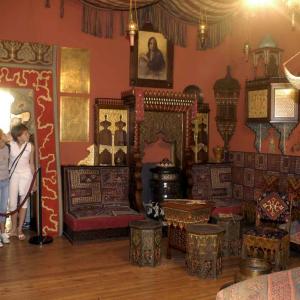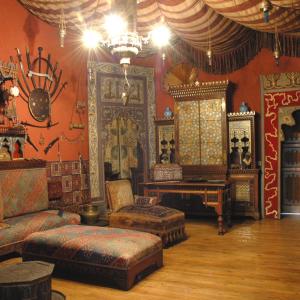The Turkish Room is a romanticised evocation of a Middle Eastern nomadic world that captivated the West of the time (as documented by many ‘Arab’, ‘Moorish’, ‘Indian’ and ‘Turkish’ rooms that where set up in Italy, Europe and North America). This world fascinated the Captain at least since 1869 when, invited by the Khedivè of Egypt and Sudan, he took part in the celebrations for the inauguration of the Suez Canal, where people from all over the world, dressed in a variety of costumes, banged into each other and jammed in the narrow meandering alleys, among curtains and canopies, and where top hats and turbans, fezzes and tarbushes, frock coats and kaftans, burnous and djellabas brushed against each other, blending in harmony. Later, when he was only 25, he was the first Italian captain to cross the Suez Canal and in the same year 1871 he attended the world premiere of Aida in Cairo, Egypt.
Under this sail-like ceiling, which simulates a tent, we are captured by soft chairs, painted and fretwork small tables, shining sabres, gilded cabinets, a stove and a fireguard, multicoloured fabrics, silk thread embroidered sandals, message holders, leather quivers and glittering jewels, together with Japanese vases, ostrich eggs, hookahs and incense burners. Some of these items were bought in their places of origin; others were purchased from furniture catalogues of the time, which we found numerous in the library, others were commissioned by the Captain himself as ‘Oriental’ style pieces of furniture in order to evoke exotic atmospheres, sounds and smells from China, Japan and the Arab World.
Surely, played a central role the "neo-Arabic" style of the cabinetmaker Giuseppe Parvis, active with his manufacturing factory in Cairo, where the Captain met him, after he took part in the World Exhibitions of Paris, Vienna, Philadelphia and, finally. at the Italian Exhibition of Milan in 1881. With payments documented in 1907 and 1908, the Captain commissioned a first tranche of work to Giuseppe Parvis and a second one, paid in 1910, 1911 and 1912, to his son Pompeo, who succeeded at the helm of the establishment upon Giuseppe's death (1909), carrying forward the style and manufacturing methodology that was so appreciated in Egypt and in the world.
The use of fabrics to create a particular atmosphere (such as the curtains hanging from the ceiling in ‘Oriental’ style) and the room overlooking a hanging garden, reveals the Captain’s familiarity with the architecture of the evoked Arab worlds, constantly wavering between the neo-Gothic and exotic styles, among copies and originals.






